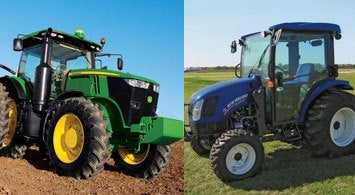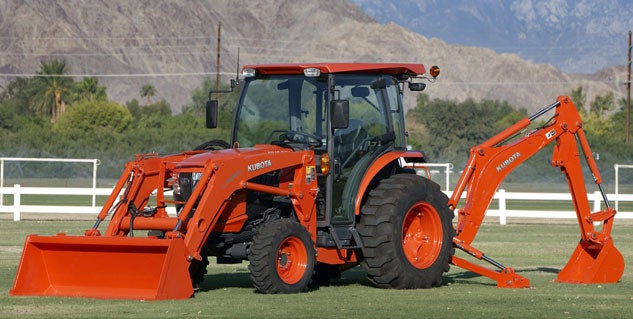
Last month we went deep on the differences between sub-compact utility tractors (SCUT) and compact utility tractors (CUT). Now we are going to focus on helping larger operations decide on what tractor to choose by comparing compact utility tractors and utility tractors (UT). We will list the plusses and minuses of each and gives you a checklist to help make that decision.
A utility tractor is a class generally defined by horsepower, ranging from 40 to 100+. The compact utility tractor class offshoot is exactly what its name infers, a utility tractor scaled down to fit in smaller spaces and take up less storage space. With the explosion of the popularity of compact utility tractors and the tasks owners demand of them, horsepower of this class has spiraled upwards to middle-of-the-range utility tractor and nearing 70.
CUT

Compact utility tractors have been around since the 70s, and are an outgrowth of the farming needs in Japan, where very little tillable soil is geographically available and the farm sizes are accordingly smaller. To get the maximum productivity from the available space, smaller and more maneuverable tractors were the solution. Initially, CUT were generally no more than 40 horsepower with tractor weight below one ton. Today, the class has grown in power, with CUT models nearing 70 hp. Though the power has increased, the recipe has not; sturdy chassis, 20 – 50+ horsepower, 2WD and 4WD models, hydraulic power, gear and hydrostatic transmissions, and a full size Cat-I three-point hitch (3PH), which means a wide range of readily available implements are compatible. Options can include 3PH fender controls, which can make attaching an implement a lot less taxing. Horsepower ratings will be gross and at the power take off (PTO).
Buying a Tractor: New vs. Used
Basics
Full frame, heavy duty construction
• 20 – 50+ hp, diesel power, 3 and 4-cylinder turbocharged powerplants
• 4WD
• Hydrostatic or gear transmission; some models will have a shuttle shift option or a powershift option
• Hydraulics – most will be open center systems with separate pumps for implement and power steering needs. Options for additional rear remotes to run a hydraulic top link or rotate a snowblower chute. Option for additional front remotes to run a grapple or a loader mounted plow. Position control will be standard. Some tractors will have draft control.
• Power steering
• Wide range of Cat-I implements including posthole diggers, backhoes, rotary cutters, and planter/seeders.
UT

Utility tractors have all the underhood features of a CUT and more. Engines output more power, frame sizes are larger, and hydraulic flow (and pressure) is higher. Electronic wizardry is also more frequently adapted, offering increased control over the output, fuel consumption and task demanded. For example, gear shifting and changing is often at the push of a joystick-mounted button or by computer control, without the need for any other operator effort, including clutching. Cabs are often standard, and in the used marketplace, available open station machines are a near rarity. And the ability to handle the increased power and hydraulic capability is spread over larger wheelbases and tire sizes. This is also a class where you begin to see dual tires, sometimes even front and back. Horsepower ratings are not only gross and at the PTO, but also at the drawbar.
Basics
Full frame, heavy duty construction
• 40 – 100+ hp, diesel power; most will have 4-cylinder engines that use variable geometry turbocharging (VGT); many will require diesel exhaust fluid (DEF) to achieve EPA Final Tier 4 (FT4) compliance
• 2WD or 4WD
• Synchro mech gear transmissions; many models will come with shuttle shift or powershift transmissions with more gears 8/8, 16/16, 20/20, 24/24 and even 32/32. Some manufacturers offer constant velocity transmissions (CVT) which operate much the same as an automotive automatic transmission.
• Hydraulics – separate pumps for implement and power steering requirements is a starting point. Many tractors will feature pressure and flow compensated systems (PFC) with up to three pumps doing duty. Options for additional rear remotes, often more in number than a CUT can accommodate, capable of controlling almost anything from a hydraulic top link up to a wide planter or grain cart. Option for additional front remotes to run a grapple, loader mounted plow, and in some cases a front 3PH. Position control will be standard and most tractors in this class will have automatic draft control with selectable degree of attack and manual overrides. Hydraulic flow rate will be greater than on a comparable horsepower CUT
• Hydrostatic power steering
• Full range of Cat-I, II and sometimes III implements, including planter/seeders, grain carts, two- and three-bottom plows, mowers, rakes, and boxes.
CUT Plusses and Minuses

Plusses
• Larger wheelbase and frame allow like-sized implements to be used. Larger implements can equate to more ground covered at the same speed.
• Position control will return an implement to an operator selectable position consistently and reliably.
• Higher hydraulic flow rates at higher hydraulic pressures will lift more and operate faster.
• Larger tires provide more traction, have greater ability to handle heavier loads, and will ride more comfortable over rough terrain.
• Requires less storage space than a UT.
• Smaller sized tires than a UT requires less horsepower to turn.
• Low to medium range horsepower engines in this class often do not require EPA Final Tier IV (FT4) compliance, avoiding the need for systems such as a diesel particulate filter (DPF) and additions such as diesel exhaust fluid (DEF). Lesser emissions requirements reduce complexity and cost.
Minuses
Implements that are larger can cost more.
• Larger size and turning radius may be too large for some plots.
• Turf damage may be increased due to size and weight, especially during turning.
• Larger engines will use more fuel.
UT Plusses and Minuses

Plusses
• Able to handle larger implements than a CUT. Larger implements cover more ground in a faster amount of time. The greater productivity equates to better usage of fuel and allows more tasks to be completed in between required maintenance down time.
• PTO options often include 540 rpm and 540E (economy), which can help save fuel during ground engaging activities.
• Electronic wizardry and added data tracking can aid in future year productivity, such as helping determine where in the field no-till can effectively be used.
• Electronics maximize productivity, especially during headland turns and on hills and slopes.
• Operator platform space is increased. Often learner/trainer seats are standard. More room equals more comfort.
• Suspension seats are usually standard with most having operator weight adjustability. Options include air ride seats for the ultimate in field comfort experience.
• More transmission gears and ranges mean a greater chance the exact speed for a given task is possible.
Minuses
• Cost is usually more than a CUT, though in the lower horsepower ranges, UT pricing can sometimes surprise.
• Lessened maneuverability when compared to a CUT.
• Greater storage requirements.
• Larger implements cost more and require more storage space.
• Service intervals, though extended, are more expensive due to the greater amount of fluids carried onboard.
• Lack of mid-PTO. If a front implement, such as a snowblower, is desired, a complex under-frame-to-rear-PTO setup is required. However, we may soon see front PTOs accompany front 3PHs and mirroring the trend in high horsepower tractors.
If it looks like a CUT can do just about everything a CT can, that is true. As with a SCUT to CUT comparison, the FEL bucket usually holds less, the hydraulic capabilities (and speed) are slightly less, transport speeds may be lower, and implements sized smaller, but the job done can be the same, just in smaller increments. Now that we’ve gone into some of the features differentiating CUTs from UTs, we’ll ask a few questions that will help steer you to the machine class that best fits your needs.

The first thing to determine is the predominate task the tractor will be used for. If mowing is your number one need and you’re adverse to looking over your shoulder at a rear mounted rotary cutter, then the need for a mid-mount may be a decision maker.
• Mid-mount mowing (CUT)
• Rear rotary mowing (UT)
Qualifier: not all CUTs have mid-PTO and mid-mount mower options, and many CUTs can handle rear rotary cutters. In the latter , though, a UT will physically be able to handle a larger size cutter.
How To Choose A Transmission For Your Tractor
If larger sized implements are a consideration, a UT will be favored owing to the larger physical footprint. But if there are space limitations or narrow paths to traverse, those larger UT implement advantages can be negated.
• Larger implements (UT)
• Smaller implements or tighter quarters (CUT)
Another major consideration is cost. This includes not only the initial cost of the tractor, but also the implements used and the cost of fuel powering larger engines.
• Cost a factor (CUT)
• Cost not a factor (UT)

Though electronics are all around us in everyday life, including on tractors, UTs generally (and especially as you look towards the middle to higher end of the class spectrum) will have more electronics onboard. If data collection and computer control are important, than a UT usually has more options available. If points and condenser simplicity of a Model T are what you’re looking for, you’re not going to find it these days; however, a CUT will tend to have less complicated electronic systems.
• Not intimidated by electronics (UT)
• Favor more basic controls (CUT)
Wrap Up

As we’ve shown, both classes of machines are capable performers, causing a purchaser of a single-use machine to have some difficulty deciding on which best fits their needs. But look at that as a good thing. This is expensive machinery. A wrong choice can prove expensive, not only in upfront monies but the impact on cost per bushel, gallon of milk, or whatever product is being brought to market.
An adage that often proves sage is to go one size larger than you think you need based on there being more purchasers that wish they had gone larger than those wishing they had gone smaller. While there is some truth and wisdom in that thinking, a smarter purchaser with take time to consider what tasks will be expected by the machine and size their purchase accordingly.
 Your Privacy Choices
Your Privacy Choices